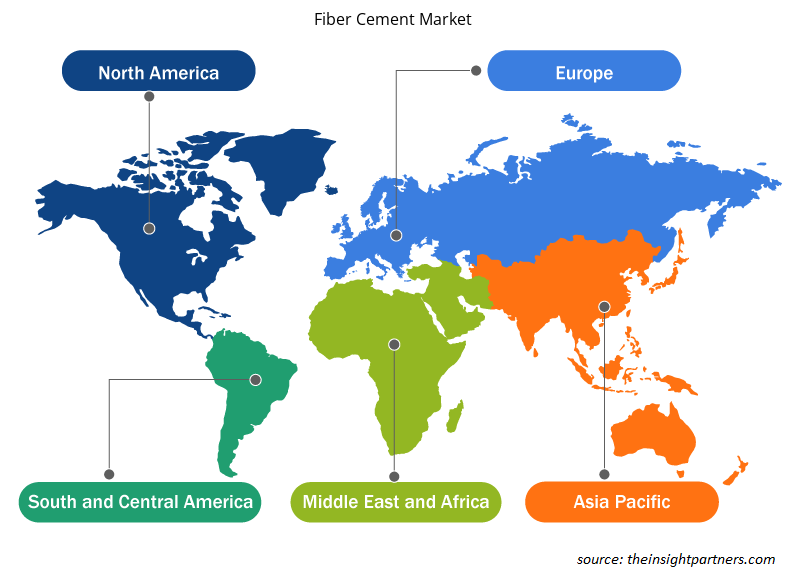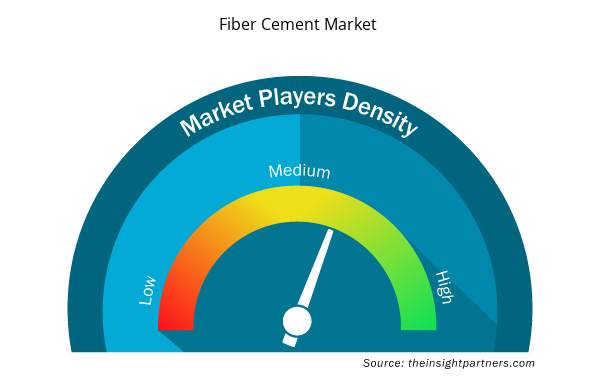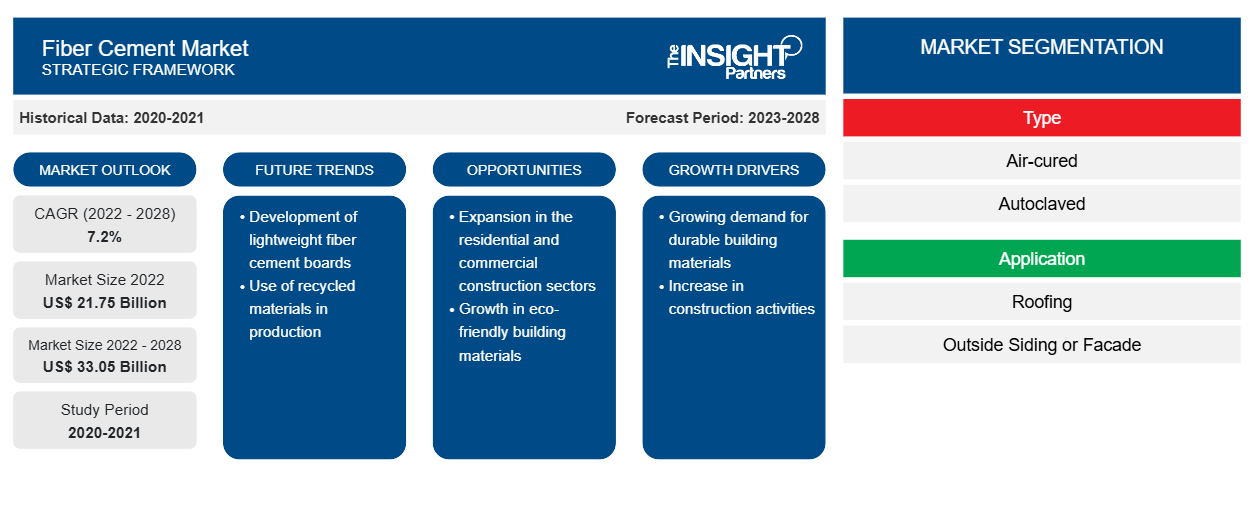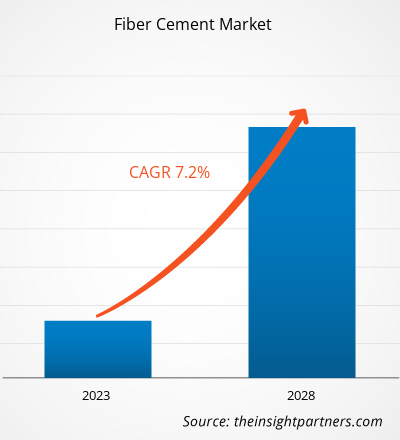[Forschungsbericht] Der Markt für Faserzement soll von 21.748,45 Millionen US-Dollar im Jahr 2022 auf 33.052,23 Millionen US-Dollar im Jahr 2028 wachsen; von 2022 bis 2028 wird eine durchschnittliche jährliche Wachstumsrate (CAGR) von 7,2 % erwartet .
Faserzement wird häufig als Außenverkleidungsmaterial verwendet, da es eine hervorragende Haltbarkeit sowie Wetter- und Feuerbeständigkeit bietet. Darüber hinaus wird Faserzement häufig als Dachmaterial verwendet, da es rauen Wetterbedingungen wie starkem Regen, Hagel und Wind standhält. Darüber hinaus kann Faserzement auch für Zier- und Fassadenarbeiten verwendet werden, da es leicht zu formen ist und gestrichen oder gebeizt werden kann, um zur Außenseite des Gebäudes zu passen. Es wird auch häufig in Gewerbegebäuden wie Krankenhäusern, Schulen und Bürogebäuden verwendet, da es eine wartungsarme, langlebige Option für deren Außenbereiche bietet.
Im Jahr 2022 hatte der asiatisch-pazifische Raum den größten Umsatzanteil am globalen Faserzementmarkt . Die Nachfrage nach Faserzement steigt im asiatisch-pazifischen Raum aufgrund des wachsenden Bewusstseins für die Vorteile von Faserzement. Diese Region gilt aufgrund des Anstiegs der Bautätigkeit als einer der wichtigsten Märkte für die Verwendung von Faserzementplatten. Darüber hinaus fördern staatliche Initiativen und Richtlinien wie Make-in-India die Einrichtung verschiedener Produktionsstätten in Indien. Steigende ausländische Direktinvestitionen führen ebenfalls zu Wirtschaftswachstum in der Region. Die wachsende Zahl der Verwendungen von Faserzementplatten in zahlreichen Wohn- und Nichtwohnsektoren wird voraussichtlich die Nachfrage nach Faserzementplatten im asiatisch-pazifischen Raum in den kommenden Jahren erhöhen. In Indien ist die Bauindustrie nach der Landwirtschaft die zweitgrößte Industrie und macht etwa 11 % des BIP des Landes aus. Die Bauindustrie trägt stark zum Wachstum des Marktes bei.
Passen Sie diesen Bericht Ihren Anforderungen an
Sie erhalten kostenlose Anpassungen an jedem Bericht, einschließlich Teilen dieses Berichts oder einer Analyse auf Länderebene, eines Excel-Datenpakets sowie tolle Angebote und Rabatte für Start-ups und Universitäten.
- Holen Sie sich die wichtigsten Markttrends aus diesem Bericht.Dieses KOSTENLOSE Beispiel umfasst eine Datenanalyse von Markttrends bis hin zu Schätzungen und Prognosen.
Auswirkungen der COVID-19-Pandemie auf den Faserzementmarkt
Der Bausektor hat am meisten zur Nachfrage nach Faserzement beigetragen. Die COVID-19-Pandemie wirkte sich negativ auf das Wachstum des Chemie- und Materialsektors und des Faserzementmarktes aus. Die Umsetzung von Maßnahmen zur Bekämpfung der Ausbreitung von SARS-CoV-2 wirkte sich negativ auf das Wachstum verschiedener Branchen aus. Branchen wie Verpackung, Konsumgüter, Automobil und Transport, Textilien sowie Bauwesen waren durch die Störungen der Betriebseffizienz und der Wertschöpfungsketten aufgrund der plötzlichen Schließung nationaler und internationaler Grenzen negativ betroffen. Während der COVID-19-Pandemie führten sinkende Einnahmen und zunehmende Herausforderungen bei der Projektabwicklung zu einer Schrumpfung des Sektors in den meisten Märkten, mit entsprechenden negativen Auswirkungen auf die Arbeitskräfte. Bauunternehmen erlebten Verzögerungen und erhöhte Kosten für importierte Rohstoffe und Baumaterialien außerhalb der Baustelle, da viele Fabriken für längere Zeit geschlossen waren. Der Schaden für die Bauindustrie behinderte die Nachfrage nach Faserzement während der Pandemie.
Markteinblicke
Steigende Nachfrage nach energieeffizienten Gebäuden fördert Wachstum auf dem Faserzementmarkt
Laut dem Energy Sector Management Assistance Program wird fast ein Drittel der weltweiten Energie in Wohn-, öffentlichen und gewerblichen Gebäuden für Raumkühlung, Heizung, Lüftung, Kochen, Kühlung, Beleuchtung, Warmwasserbereitung und den Betrieb elektrischer und mechanischer Geräte verbraucht. Die Modernisierung von Städten in Entwicklungsländern und das steigende Pro- Kopf- Einkommen treiben den Energieverbrauch in Gebäuden weltweit voran. Der hohe Energieverbrauch in öffentlichen, Wohn- und gewerblichen Gebäuden schafft einen Bedarf an Energieeinsparungen. Laut der Internationalen Energieagentur werden Gebäude bis 2035 voraussichtlich etwa 41 % des weltweiten Energieeinsparpotenzials ausmachen, und der Industriesektor und der Verkehrssektor werden 24 % bzw. 21 % ausmachen. Eine Schicht Faserzement wird auf das Gebäude aufgetragen, um die Wärmeübertragung durch die Wände zu reduzieren und das Innere im Winter wärmer und im Sommer kühler zu halten, was zur Reduzierung des Energieverbrauchs beiträgt. Laut dem ASHRAE Fundamentals Handbook hat Faserzement einen R-Wert von 0,15, der besser ist als der Wert von Ziegel und Stein.
Typ-Einblicke
Der globale Markt für Faserzement ist nach Typ in luftgehärtet und autoklaviert unterteilt. Das Segment der autoklavierten Faserzemente hatte im Jahr 2022 einen größeren Marktanteil. Autoklavierter Faserzement wird aus einer Mischung aus Zement, Sand, Zellulosefasern und anderen Zusatzstoffen hergestellt. Die Mischung wird zu Platten geformt und dann in einem Autoklaven ausgehärtet, einem Hochdruckbehälter, der das Material mit Hitze und Dampf beaufschlagt. Der Autoklavierungsprozess verursacht eine chemische Reaktion, die das Material stärkt und es haltbarer und widerstandsfähiger gegen Wasser, Feuer und Schädlinge macht. Er wird im Allgemeinen in einer Vielzahl von Anwendungen eingesetzt, darunter Bedachungen, Fassadenverkleidungen, Fußböden und als Unterlage für Keramikfliesen . Darüber hinaus ist autoklavierter Faserzement auch für seine Vielseitigkeit und Designflexibilität bekannt, da er so hergestellt werden kann, dass er das Aussehen anderer Baumaterialien wie Holz oder Stein nachahmt. Er ist auch in verschiedenen Farben und Texturen erhältlich, was ihn zu einer beliebten Wahl sowohl für Wohn- als auch für Gewerbebauprojekte macht.
James Hardie Industries plc, Etex NV, Swisspearl Group AG, CSR Ltd, NICHIHA Corp, Plycem Construsistemas Costa Rica SA, Compagnie de Saint Gobain SA, Century Plyboards Ltd, Everest Industries Ltd und Isam Khairi Kabbani Group sind einige der wichtigsten Akteure auf dem globalen Markt für Faserzement. Die Marktteilnehmer konzentrieren sich darauf, qualitativ hochwertige Produkte anzubieten, um die Kundennachfrage zu erfüllen. Sie verfolgen auch Strategien wie Investitionen in Forschungs- und Entwicklungsaktivitäten und die Einführung neuer Produkte.
Bericht-Spotlights
- Fortschrittliche Branchentrends auf dem Faserzementmarkt helfen den Akteuren bei der Entwicklung wirksamer langfristiger Strategien
- In Industrie- und Entwicklungsländern angewandte Strategien für Unternehmenswachstum
- Quantitative Analyse des Faserzementmarktes von 2020 bis 2028
- Schätzung der weltweiten Nachfrage nach Faserzement
- Porters Fünf-Kräfte-Analyse zur Veranschaulichung der Wirksamkeit der in der Branche tätigen Käufer und Lieferanten
- Aktuelle Entwicklungen zum Verständnis des wettbewerbsorientierten Marktszenarios
- Markttrends und -aussichten sowie Faktoren, die das Wachstum des Faserzementmarktes vorantreiben und bremsen
- Unterstützung im Entscheidungsprozess durch Aufzeigen von Marktstrategien, die das kommerzielle Interesse untermauern und zum Marktwachstum führen
- Die Größe des Faserzementmarktes an verschiedenen Knotenpunkten
- Detaillierte Übersicht und Segmentierung des Marktes sowie der Dynamik der Faserzementindustrie
- Die Größe des Faserzementmarktes in verschiedenen Regionen mit vielversprechenden Wachstumschancen
Regionale Einblicke in den Faserzementmarkt
Die regionalen Trends und Faktoren, die den Faserzementmarkt während des Prognosezeitraums beeinflussen, wurden von den Analysten von Insight Partners ausführlich erläutert. In diesem Abschnitt werden auch die Marktsegmente und die Geografie des Faserzementmarkts in Nordamerika, Europa, im asiatisch-pazifischen Raum, im Nahen Osten und Afrika sowie in Süd- und Mittelamerika erörtert.

- Erhalten Sie regionale Daten zum Faserzementmarkt
Umfang des Marktberichts zu Faserzement
| Berichtsattribut | Details |
|---|---|
| Marktgröße im Jahr 2022 | 21,75 Milliarden US-Dollar |
| Marktgröße bis 2028 | 33,05 Milliarden US-Dollar |
| Globale CAGR (2022 - 2028) | 7,2 % |
| Historische Daten | 2020-2021 |
| Prognosezeitraum | 2023–2028 |
| Abgedeckte Segmente | Nach Typ
|
| Abgedeckte Regionen und Länder | Nordamerika
|
| Marktführer und wichtige Unternehmensprofile |
|
Marktteilnehmerdichte: Der Einfluss auf die Geschäftsdynamik
Der Markt für Faserzement wächst rasant, angetrieben durch die steigende Nachfrage der Endverbraucher aufgrund von Faktoren wie sich entwickelnden Verbraucherpräferenzen, technologischen Fortschritten und einem größeren Bewusstsein für die Vorteile des Produkts. Mit steigender Nachfrage erweitern Unternehmen ihr Angebot, entwickeln Innovationen, um die Bedürfnisse der Verbraucher zu erfüllen, und nutzen neue Trends, was das Marktwachstum weiter ankurbelt.
Die Marktteilnehmerdichte bezieht sich auf die Verteilung der Firmen oder Unternehmen, die in einem bestimmten Markt oder einer bestimmten Branche tätig sind. Sie gibt an, wie viele Wettbewerber (Marktteilnehmer) in einem bestimmten Marktraum im Verhältnis zu seiner Größe oder seinem gesamten Marktwert präsent sind.
Die wichtigsten auf dem Faserzementmarkt tätigen Unternehmen sind:
- James Hardie Industries plc
- Etex NV
- Swisspearl Group AG
- CSR GmbH
- NICHIHA Corp
Haftungsausschluss : Die oben aufgeführten Unternehmen sind nicht in einer bestimmten Reihenfolge aufgeführt.

- Überblick über die wichtigsten Akteure auf dem Faserzementmarkt
Globaler Markt für Faserzement
Basierend auf dem Fasertyp ist der globale Faserzementmarkt nach Typ, Anwendung und Endverbrauch segmentiert. Basierend auf dem Typ ist der globale Faserzementmarkt in luftgehärtet und autoklaviert segmentiert. Basierend auf der Anwendung ist der Faserzementmarkt in Bedachungen, Außenverkleidungen oder Fassaden und Sonstiges segmentiert. Basierend auf der Endnutzung ist der Faserzementmarkt in Wohn- und Nichtwohngebäude segmentiert.
Firmenprofile
- James Hardie Industries plc
- Etex NV
- Swisspearl Group AG
- CSR GmbH
- NICHIHA Corp
- Plycem Construsistemas Costa Rica SA
- Compagnie de Saint Gobain SA
- Century Plyboards Ltd
- Everest Industries Ltd
- Isam Khairi Kabbani Gruppe
- Historische Analyse (2 Jahre), Basisjahr, Prognose (7 Jahre) mit CAGR
- PEST- und SWOT-Analyse
- Marktgröße Wert/Volumen – Global, Regional, Land
- Branche und Wettbewerbsumfeld
- Excel-Datensatz


- Legal Case Management Software Market
- Trade Promotion Management Software Market
- Latent TB Detection Market
- MEMS Foundry Market
- Social Employee Recognition System Market
- Asset Integrity Management Market
- Green Hydrogen Market
- Hydrolyzed Collagen Market
- Non-Emergency Medical Transportation Market
- Dealer Management System Market

Report Coverage
Revenue forecast, Company Analysis, Industry landscape, Growth factors, and Trends

Segment Covered
This text is related
to segments covered.

Regional Scope
North America, Europe, Asia Pacific, Middle East & Africa, South & Central America

Country Scope
This text is related
to country scope.
Häufig gestellte Fragen
Asia Pacific accounted for the largest share of the global fiber cement market. Asia Pacific is one of the most significant regions for the fiber cement market owing to surging demand for energy-efficient buildings.
Durability is one of the most desirable qualities of fiber cement. Fiber cement siding, boards, and panels typically outlast vinyl siding and other alternative products in lifespan. Within 10 to 15 years, vinyl siding can show signs of aging, whereas fiber cement siding can last up to 30 to 50 years or more. Further, in cement production, carbon dioxide is a byproduct. However, manufacturing vinyl siding containing polyvinyl chloride (PVC) produces more carbon dioxide than cement production. Hence, fiber cement siding is a greener alternative to vinyl siding. Fiber cement products do not require frequent repainting as it holds paint well. Also, they do not dent unlike steel siding. Fiber cement products stand stronger in moisture and leaks than gypsum boards. These products possess excellent moisture-absorbing and drying properties, making them resistant to weather changes.
Based on type, autoclaved segment held the largest revenue share owing to the its durability and resistance to water, fire, and pests.
Based on the application, roofing segment is projected to grow at the fastest CAGR over the forecast period. Fiber cement roofing sheets and tiles are popular for their durability, resistance to weathering, and low maintenance requirements. They are also available in a variety of colors and styles to suit multiple architectural requirements and design preferences.
According to the World Bank, across the world, a large proportion of the population lives in cities. In 2011, 52.0% lived in urban areas. Over the last ten years, owing to urbanization in developing economies in Asia and Oceania, the urbanization rate increased from 43.3% in 2011 to 50.0% in 2021. Africa has seen a 4.6% increase in the same period. Governments of various countries across the world focus on supporting and increasing construction activities. Saudi Arabia launched its Saudi Vision 2030 to diversify its economy, modernize its administration, and introduce bold reforms in many sectors. The country is targeting to increase the contribution of its construction sector to the overall GDP. Due to its Saudi Vision 2030, the country's construction market reports significant growth in residential and nonresidential segments and offers lucrative potential to fiber cement.
The major players operating in the global fiber cement market are James Hardie Industries plc, Etex NV, Swisspearl Group AG, CSR Ltd, NICHIHA Corp, Plycem Construsistemas Costa Rica SA, Compagnie de Saint Gobain SA, Century Plyboards Ltd, Everest Industries Ltd, and Isam Khairi Kabbani Group.
Trends and growth analysis reports related to Chemicals and Materials : READ MORE..
The List of Companies - Fiber Cement Market
- James Hardie Industries plc
- Etex NV
- Swisspearl Group AG
- CSR Ltd
- NICHIHA Corp
- Plycem Construsistemas Costa Rica SA
- Compagnie de Saint Gobain SA
- Century Plyboards Ltd
- Everest Industries Ltd
- Isam Khairi Kabbani Group
The Insight Partners performs research in 4 major stages: Data Collection & Secondary Research, Primary Research, Data Analysis and Data Triangulation & Final Review.
- Data Collection and Secondary Research:
As a market research and consulting firm operating from a decade, we have published and advised several client across the globe. First step for any study will start with an assessment of currently available data and insights from existing reports. Further, historical and current market information is collected from Investor Presentations, Annual Reports, SEC Filings, etc., and other information related to company’s performance and market positioning are gathered from Paid Databases (Factiva, Hoovers, and Reuters) and various other publications available in public domain.
Several associations trade associates, technical forums, institutes, societies and organization are accessed to gain technical as well as market related insights through their publications such as research papers, blogs and press releases related to the studies are referred to get cues about the market. Further, white papers, journals, magazines, and other news articles published in last 3 years are scrutinized and analyzed to understand the current market trends.
- Primary Research:
The primarily interview analysis comprise of data obtained from industry participants interview and answers to survey questions gathered by in-house primary team.
For primary research, interviews are conducted with industry experts/CEOs/Marketing Managers/VPs/Subject Matter Experts from both demand and supply side to get a 360-degree view of the market. The primary team conducts several interviews based on the complexity of the markets to understand the various market trends and dynamics which makes research more credible and precise.
A typical research interview fulfils the following functions:
- Provides first-hand information on the market size, market trends, growth trends, competitive landscape, and outlook
- Validates and strengthens in-house secondary research findings
- Develops the analysis team’s expertise and market understanding
Primary research involves email interactions and telephone interviews for each market, category, segment, and sub-segment across geographies. The participants who typically take part in such a process include, but are not limited to:
- Industry participants: VPs, business development managers, market intelligence managers and national sales managers
- Outside experts: Valuation experts, research analysts and key opinion leaders specializing in the electronics and semiconductor industry.
Below is the breakup of our primary respondents by company, designation, and region:

Once we receive the confirmation from primary research sources or primary respondents, we finalize the base year market estimation and forecast the data as per the macroeconomic and microeconomic factors assessed during data collection.
- Data Analysis:
Once data is validated through both secondary as well as primary respondents, we finalize the market estimations by hypothesis formulation and factor analysis at regional and country level.
- Macro-Economic Factor Analysis:
We analyse macroeconomic indicators such the gross domestic product (GDP), increase in the demand for goods and services across industries, technological advancement, regional economic growth, governmental policies, the influence of COVID-19, PEST analysis, and other aspects. This analysis aids in setting benchmarks for various nations/regions and approximating market splits. Additionally, the general trend of the aforementioned components aid in determining the market's development possibilities.
- Country Level Data:
Various factors that are especially aligned to the country are taken into account to determine the market size for a certain area and country, including the presence of vendors, such as headquarters and offices, the country's GDP, demand patterns, and industry growth. To comprehend the market dynamics for the nation, a number of growth variables, inhibitors, application areas, and current market trends are researched. The aforementioned elements aid in determining the country's overall market's growth potential.
- Company Profile:
The “Table of Contents” is formulated by listing and analyzing more than 25 - 30 companies operating in the market ecosystem across geographies. However, we profile only 10 companies as a standard practice in our syndicate reports. These 10 companies comprise leading, emerging, and regional players. Nonetheless, our analysis is not restricted to the 10 listed companies, we also analyze other companies present in the market to develop a holistic view and understand the prevailing trends. The “Company Profiles” section in the report covers key facts, business description, products & services, financial information, SWOT analysis, and key developments. The financial information presented is extracted from the annual reports and official documents of the publicly listed companies. Upon collecting the information for the sections of respective companies, we verify them via various primary sources and then compile the data in respective company profiles. The company level information helps us in deriving the base number as well as in forecasting the market size.
- Developing Base Number:
Aggregation of sales statistics (2020-2022) and macro-economic factor, and other secondary and primary research insights are utilized to arrive at base number and related market shares for 2022. The data gaps are identified in this step and relevant market data is analyzed, collected from paid primary interviews or databases. On finalizing the base year market size, forecasts are developed on the basis of macro-economic, industry and market growth factors and company level analysis.
- Data Triangulation and Final Review:
The market findings and base year market size calculations are validated from supply as well as demand side. Demand side validations are based on macro-economic factor analysis and benchmarks for respective regions and countries. In case of supply side validations, revenues of major companies are estimated (in case not available) based on industry benchmark, approximate number of employees, product portfolio, and primary interviews revenues are gathered. Further revenue from target product/service segment is assessed to avoid overshooting of market statistics. In case of heavy deviations between supply and demand side values, all thes steps are repeated to achieve synchronization.
We follow an iterative model, wherein we share our research findings with Subject Matter Experts (SME’s) and Key Opinion Leaders (KOLs) until consensus view of the market is not formulated – this model negates any drastic deviation in the opinions of experts. Only validated and universally acceptable research findings are quoted in our reports.
We have important check points that we use to validate our research findings – which we call – data triangulation, where we validate the information, we generate from secondary sources with primary interviews and then we re-validate with our internal data bases and Subject matter experts. This comprehensive model enables us to deliver high quality, reliable data in shortest possible time.


 Holen Sie sich ein kostenloses Muster für diesen Bericht
Holen Sie sich ein kostenloses Muster für diesen Bericht